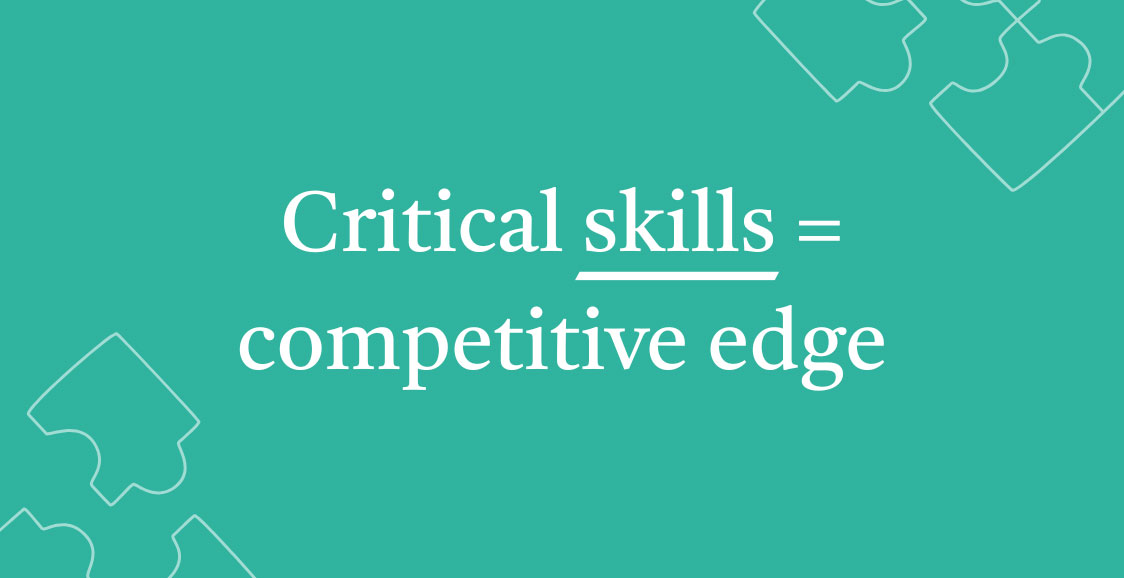More and more, talent acquisition and talent management teams are joining forces. They’re building connected processes where recruiting, onboarding and development all work together. The goal is simple: focus on the skills that matter most for business success and employee growth.
Identifying the right skills isn’t always simple. Roles are evolving rapidly, new technologies keep emerging, and the skills your people need today could look very different from what they’ll need tomorrow.
That’s why building a clear, skills-first approach has never been more important. Let’s dive into how to master critical skills within your organisationorganization.
Why identifying critical skills matters
Critical skills are the capabilities your business relies on most. They’re not just hard, technical skills. Think soft skills that are often harder to learn – like adaptability, leadership and creative thinking. These skills fuel performance, innovation and growth.
In today’s market, skills are the backbone of talent acquisition and management strategies. They are being used to navigate top HR priorities including:
- Upskilling and reskilling in employee development
- Skills-based hiring in talent acquisition
- Internal mobility to unlock talent from within
When you know what your critical skills are, you can make better decisions about how to hire, develop and retain your people. This lets you move forward and be more confident that your workforce is ready for what’s next.
1. Align skills with business goals
Start by getting clear on what your business is trying to achieve. Are you entering new markets? Launching new products? Improving customer experience?
Every big goal needs skills to make it happen. Once you know the goals, work with business leaders to map the skills needed to get there. Make this a regular conversation – as business priorities shift, your skills needs will too.
2. Understand your skills gap
Next, take stock of the skills you already have, and the skills you’re missing.
Use a skills gap analysis to see where you stand today. Look at employee assessments, performance reviews and feedback data. Tap into managers’ knowledge of their team’s strengths and where there are gaps. This will reveal where to focus your hiring and development efforts.
According to Mercer, 33% of organisationsorganizations are now actively investing in employee skills development and better talent assessment. Understanding where you stand today is the foundation of smarter, future-focused decisions.
3. Connect talent acquisition and talent management
Recruitment and employee development are working side-by-side more than ever. Hiring managers and talent teams should work together to find people with the skills and potential to grow. Look beyond what’s on a CV – focus on skills, mindset and capacity to learn.
This is the heart of skills-based hiring, which is being increasingly adopted as more organisationsorganizations rethink traditional recruitment practices. Korn Ferry calls this shift “retaining by training” – bringing in people with potential, and then giving them the tools to thrive.
Once people are part of the team, keep building on those skills. Create clear pathways for growth and a culture of ongoing learning. Offer stretch assignments, mentoring and learning opportunities that build on the skills you hired them for. This will help candidates and employees see a future with your business, whilst helping your business stay ahead.
4. Build a skills framework
A skills framework is your guidebook. It outlines the key skills needed across different roles, teams and levels. This is often where teams can get stuck. Our advice – keep it simple. Keep it flexible. And keep it evolving.
A good framework helps recruiters find the right people. It helps managers have better development conversations, and helps employees understand what’s expected of them and what’s possible next.
5. Make internal mobility part of your culture
When you know what skills exist in your business, you can create real opportunities for people to move and grow internally. Internal mobility helps you fill skill gaps faster and is 12 times more effective at finding the right person than hiring through job boards. It shows employees that they don’t have to leave to level up, and it makes the most of the talent you already have.
49% of organisationsorganizations are improving their workforce planning to better inform whether they should buy, build or borrow talent. Internal mobility plays a big role in that strategy.
Make it easy for people to explore internal moves with a dedicated careers page for employees. Share success stories. Encourage managers to have honest career conversations, and create pathways that support skills development across different roles and teams.
6. Embed skills across the employee experience
This is where it all comes to life. The best skills strategies show up in everyday moments.
- Recruiting: Write job ads that focus on the skills that matter most and incorporate skills based assessment to assess candidates.
- Onboarding: Set new hires up with the tools and learning modules they need from day one.
- Development: Offer training, mentoring and opportunities that build the skills your business needs.
- Performance: Give regular feedback on skills growth, not just task delivery.
- Career paths: Show people how building new skills opens doors to new opportunities.
Upskilling and reskilling your existing workforce will enable you to stay ahead in a fast-moving market. It helps you enhance employee engagement, retain top talent and respond quickly to change. Because no matter how roles evolve or technology shifts, you’ll have a workforce that’s ready to learn, grow and adapt.
Final thoughts
Identifying and defining critical skills is one of the smartest things any business can do. It forges a vital link between talent strategy with business strategy. And it lays the foundation for the kind of workplace where people and performance thrive.
This isn’t just about filling today’s roles. It’s about future-proofing your workforce for whatever comes next. Get the skills right, and the rest will follow.






